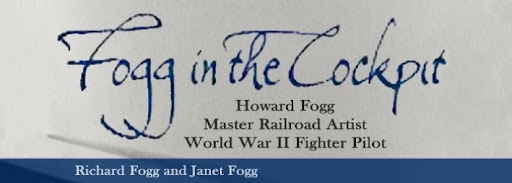 This excerpt from Fogg in the Cockpit is from the narrative History of the 359th Fighter Group, Office of the Group Historian, June 1944 dated 4 July 1944:
This excerpt from Fogg in the Cockpit is from the narrative History of the 359th Fighter Group, Office of the Group Historian, June 1944 dated 4 July 1944:On D plus 2, the heavies went after the bridges over the Loire, seeking to snap the fabric of the railroads there as medium bombers had previously chopped every line over the Seine.
There was a FO (377) but it was not in until 0425 and the effect was a hurried briefing at 0515 by Colonel Murphy.
Again the weather was execrable, haze and low ceiling, but Colonel Murphy discussed all that in a memorable line (“Weather is weather, and all weather is bad.”) and by 0627, when 45 planes took off, the mist had in fact cleared, although scud and mist rolled back over the field for the landing at 1150. There was a great score for strafing, especially in the 369th Squadron, which caught a German convoy control point at a crossroads and wiped out 26-odd vehicles.
But by now the Germans had light flak guns by the dozen at every vulnerable point, and there were two losses, 1st Lieutenant Benjamin M. Hagan III, one of the 368th Squadron originals, and Lieutenant Robert B. Sander, of the 369th. Sander was believed to have crashed in the woods near the control point but Hagan jumped after being hit in a wild strafing bee on a train southeast of Breteuil. The tall, lean, dour-faced jokester owned a questing mind, fortified by a rare depth of spirit. Aged 19 when he arrived in England, he had lived a curiously full life, although all of this was customarily masked in the prankery by which he was best known. He habitually explained he had become a fighter pilot to escape the perils of the explosives plant where he had been working and it was usually impossible to decide at what, if any point, his fantasies ceased to be fact. Two friends, Earl Perkins and Bill Simmons, followed him down and though his chute was afire when he jumped, both saw it later, empty, in a field.
-------------------------------------------
Photo: Brigadier General Edward W. Anderson presenting the Distinguished Flying Cross to Lieutenant Benjamin M. “Hag” Hagen III. April 13, 1944 photo courtesy of R. Hatter: Archived by Char Baldridge, Historian, 359th Fighter Group Association.
Transcribed by Char Baldridge, Historian, 359th Fighter Group Association, from reports filed by Maurice F. X. Donohue, 359th Fighter Group historian and combat intelligence officer, from the original monthly narrative History of the 359th Fighter Group archived at HQ USAF Historical Research Center, Maxwell Air Force Base, Alabama.







